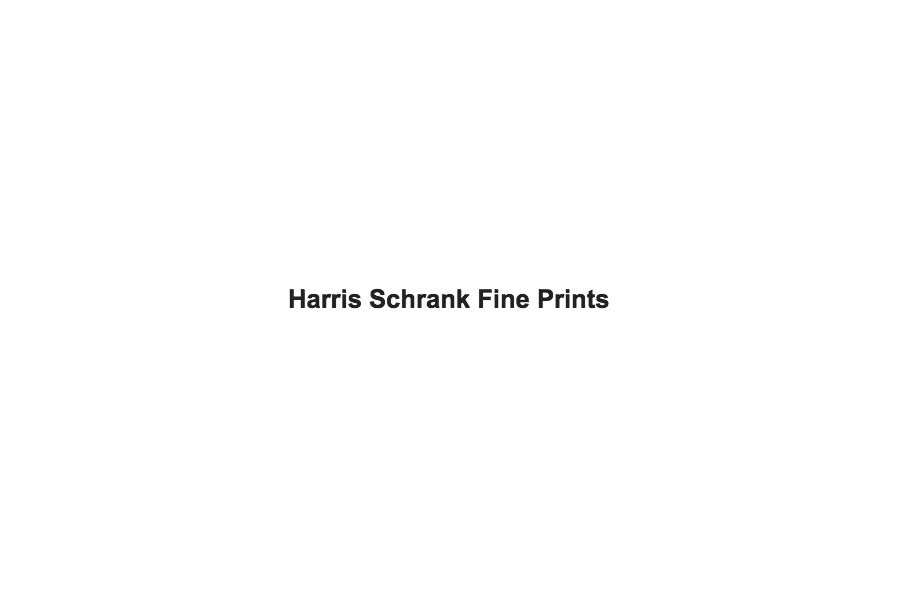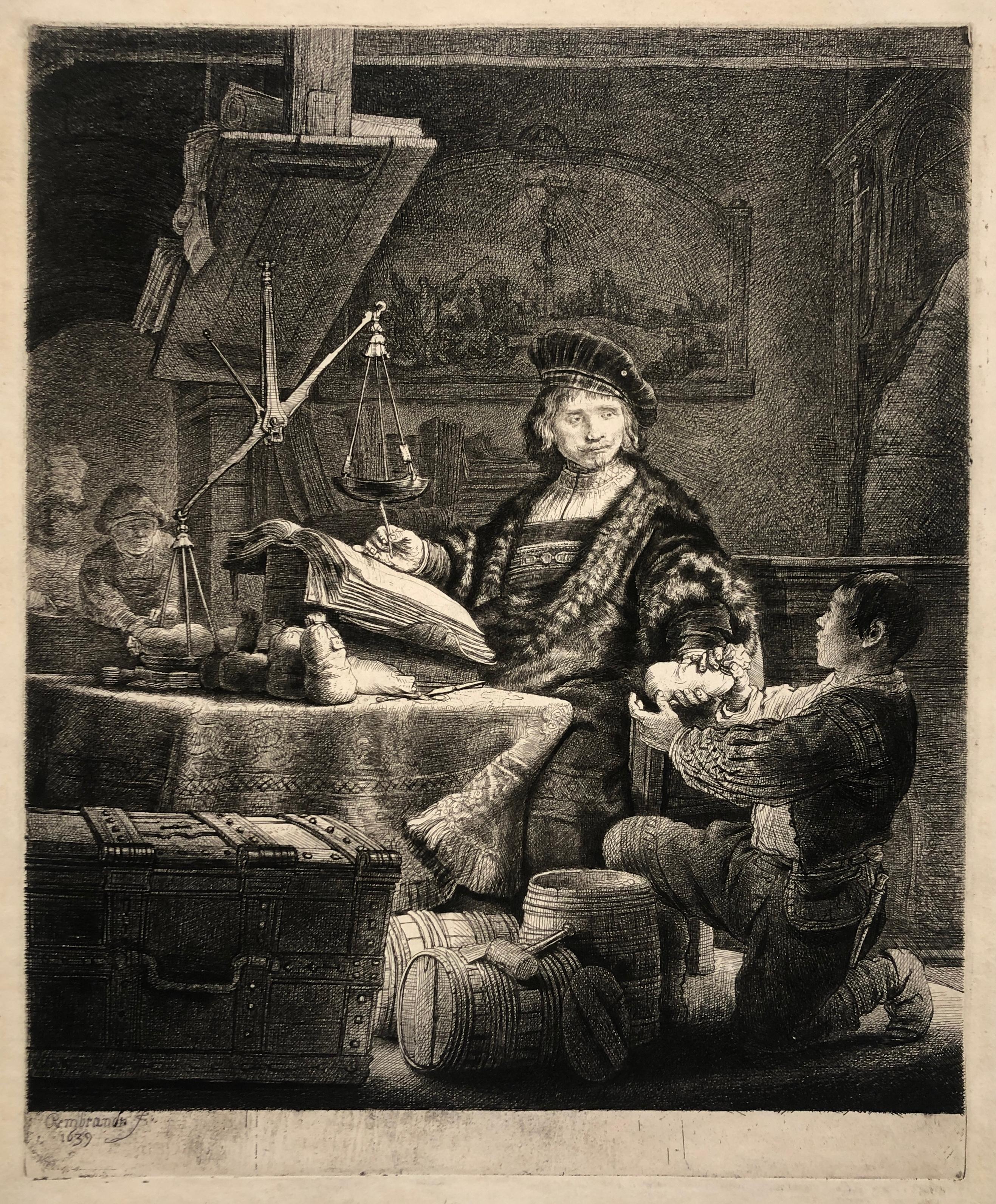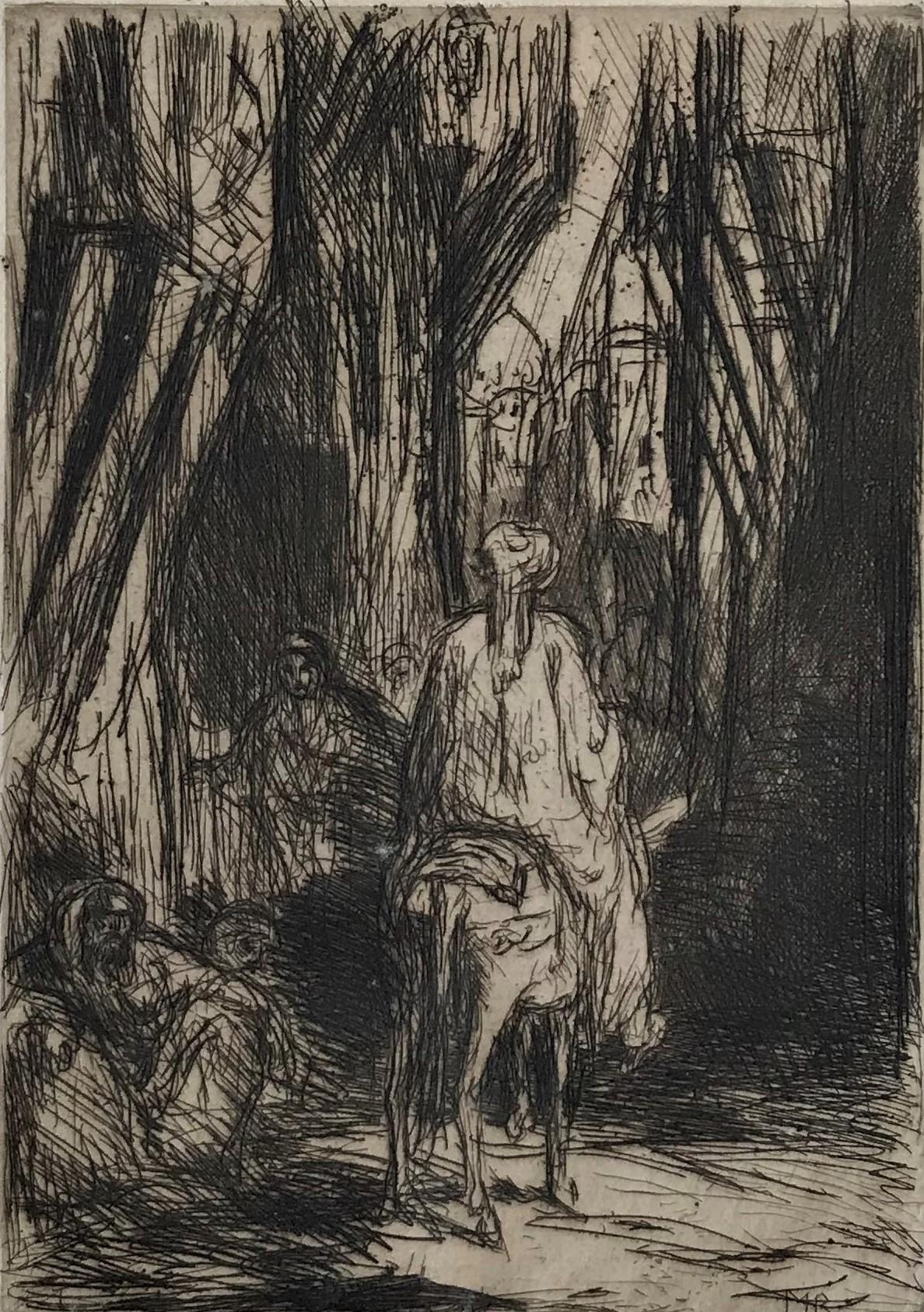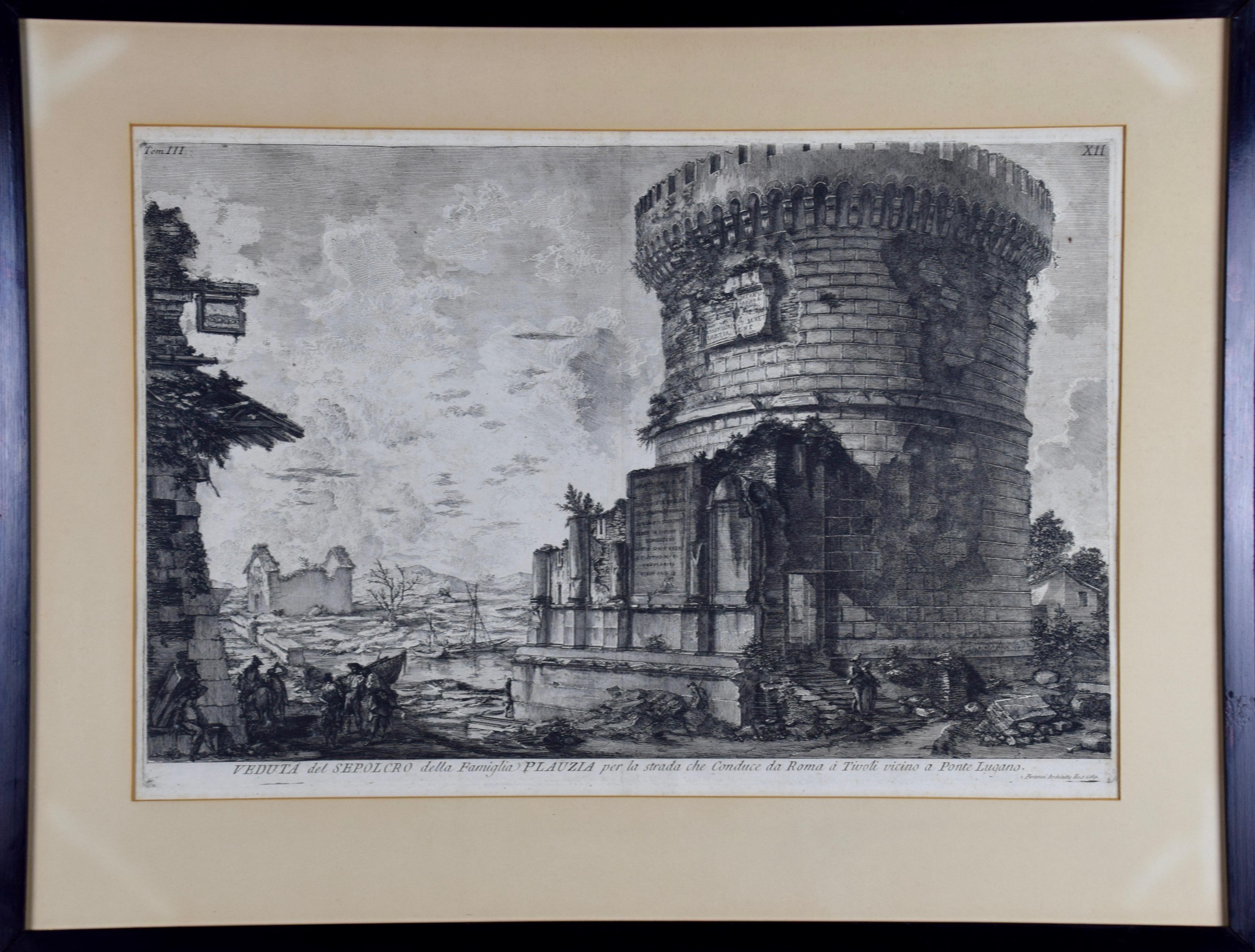Items Similar to One Can't Tell Why - Proof from the Disasters of War
Want more images or videos?
Request additional images or videos from the seller
1 of 2
Francisco GoyaOne Can't Tell Why - Proof from the Disasters of Warc. 1808-1814
c. 1808-1814
About the Item
Francisco José de Goya y Lucientes (1746 Fuendetodos – Bordeaux 1828), No se puede saber por qué – One can’t tell why ca. 1808–1814, etching, burnished aquatint, drypoint, and burin on laid paper; 155 x 203 mm (6 1/8 x 8 inches), Harris 155.I.2 (of III.7)
provenance
Infante Don Sebastian de Borbón y Braganza
Georges Provôt, Paris; his sale, Hôtel Drouot, April 10, 1935, lot 64
Tomás Harris, London (not in Lugt)
private collection, Germany
A fine, rich proof impression for plate 35 of Los Desastres de la Guerra, before numbers, letters, and before additional drypoint and burin work.
No impression of state I.1 (before the aquatint) is known nor are any proof impressions with numbers (Harris’ hypothetical state I.3) known. Harris lists nine impressions of state I.2, including this one. This is a lifetime impression; the edition was published posthumously.
No less than eight convicts are about to be garroted. Each man clutches a crucifix—a sign that they have already made their last confession. Their crime—ownership of a weapon— is announced on placards hanging around their necks, alongside the weapons themselves. Many Spanish citizens were executed this way. Their crimes were not only murder and armed robbery; suspicion of espionage for the insurgents or any other support for them was sufficient to subject the accused to this cruel fate.
An impression from the edition can be included with this purchase.
- Creator:Francisco Goya (1746 - 1928, Spanish)
- Creation Year:c. 1808-1814
- Medium:
- Movement & Style:
- Period:
- Condition:
- Gallery Location:New York, NY
- Reference Number:1stDibs: LU51531463373
Francisco Goya
Francisco José de Goya y Lucientes (1746-1828) was a Spanish romantic painter and printmaker. He is considered the most important Spanish artist of the late 18th and early 19th centuries. His works often contained a social message, like in his "Disasters of War" series. Immensely successful in his lifetime, Goya is often referred to as both the last of the Old Masters and the first of the moderns. He was also one of the great portraitists of his time.

About the Seller
4.9
Recognized Seller
These prestigious sellers are industry leaders and represent the highest echelon for item quality and design.
Established in 2000
1stDibs seller since 2016
99 sales on 1stDibs
Typical response time: 3 hours
Associations
International Fine Print Dealers Association
- ShippingRetrieving quote...Ships From: New York, NY
- Return PolicyA return for this item may be initiated within 7 days of delivery.
More From This SellerView All
- Disparate Pobre (Two Heads are Better Than One) – Trial ProofBy Francisco GoyaLocated in New York, NYFrancisco de Goya y Lucientes (1746-1828), Disparate Pobre (Two Heads are Better Than One) – Trial Proof, with burnished aquatint, drypoint and engraving, c. 1812; plate 11 from Los...Category
1810s Old Masters Figurative Prints
MaterialsEngraving, Drypoint, Etching, Aquatint
- Descending from the Cross, by TorchlightBy Rembrandt van RijnLocated in New York, NYRembrandt Harmensz. van Rijn 1606 Leiden – Amsterdam 1669 The Descent from the Cross by Torchlight 1654 etching and drypoint; sheet 213 x 163 mm (8 3/8 x 6 7/16 inches) Bart...Category
17th Century Old Masters Figurative Prints
MaterialsDrypoint, Etching
- Mother EarthBy William Strang, R.A., R.E.Located in New York, NYWilliam Strang (1859-1921), Mother Earth, 1897, etching, drypoint, aquatint ); signed in pencil lower right, and signed by the printer David Strang and...Category
1890s Symbolist Figurative Prints
MaterialsDrypoint, Etching, Aquatint
- Resurrection (aka Flying Figures; Border of the Lake)By Arthur B. DaviesLocated in New York, NYArthur B. Davies (1862-1928), Resurrection (aka Flying Figures; Border of the Lake), drypoint and aquatint on zinc, 1916, signed with the estate stamp lower right. Reference: Price 2...Category
1910s American Impressionist Figurative Prints
MaterialsDrypoint, Aquatint
- AuctionBy Bernhard KretzschmarLocated in New York, NYBernard Kretzschmar (1889-1972), Auction, etching, drypoint, and burnished aquatint, 1921, signed and dated (’20) in pencil lower right [also initialed in the plate lower left] Refe...Category
1920s Expressionist Figurative Prints
MaterialsDrypoint, Etching, Aquatint
- Minne Playing with a Cat (Minne Jouant avec un Chat)By Jacques VillonLocated in New York, NYJacques Villon (1875-1963) etching, aquatint, and drypoint, Minne Playing with a Cat (Minne Jouant avec un Chat),1907, signed in pencil and numbered (12/30)(Ginestet and Pouillon 192...Category
Early 1900s Impressionist Figurative Prints
MaterialsDrypoint, Etching, Aquatint
You May Also Like
- Jan Uytenbogaert, The GoldweigherBy Rembrandt van RijnLocated in Boston, MABartsch 281, Hind 167 iii/III, Nowell-Usticke 281, iii/III. A fine impression, with burr, as retouched by Baillie in 1792. With an unidentified collectors stamp, verso.Category
17th Century Old Masters Figurative Prints
MaterialsDrypoint, Etching
- Breaking up of the Agamemnon, No 1By Sir Francis Seymour Haden, R.A.Located in Storrs, CTEtching and drypoint. Schneiderman 133.v/xi. 7 3/4 x 16 3/8 (sheet 9 1/4 x 17 1/2). A rich impression with plate tone printed in black/brown in on antique cream wove paper. Signed in...Category
Mid-19th Century Old Masters Landscape Prints
MaterialsDrypoint, Etching
- Street in SmyrnaBy Marius BauerLocated in Storrs, CTStreet in Smyrna. 1889. Etching. Wisselingh 34. 7 x 5 1/4 (sheet 12 7/8 x 8 7/8).Edition 100, number 49. A rich, tonal impression printed on Strasbourg cream laid paper on the full s...Category
Late 19th Century Old Masters Figurative Prints
MaterialsDrypoint, Etching
- Giovanni Piranesi Etching of Ancient Roman Architecture, 18th CenturyBy Giovanni Battista PiranesiLocated in Alamo, CA"Veduta del Sepolcro della Famiglia Plauzia per la Strada Che Conduce da Roma a Tivoli vicino a Ponte Lugano" from "Le Antichità Romane" (Roman Antiquities), one of the most famous works by Piranesi. "Antichita" illustrates the tombs along the Appian Way...Category
Early 18th Century Old Masters Figurative Prints
MaterialsDrypoint, Engraving, Etching
- Study of Six Heads - Etching by J.-J. BoissieuBy Jean-Jacques de BoissieuLocated in Roma, ITStudy of Six Heads is a beautiful black and white etching with drypoint interventions on paper, realized at the end of XVIII century by the French artist Jean-Jacques de Boissieu (Lyon, 1736- 1810). Six study od heads ( four elder men, a middle-aged man at the center, and a woman with turbant) etched with a superb technique and an incredible draftsmanship are drawn to different scales and with different degrees of finish, have the dignity of six different portraits with the same passion and effort. Signed on plate on lower right margin “De Boissieu”. Inscription ( number plate) on higher-right corner "10". This old master’s original print with lifetime impressions, is in very good conditions, except for a usual yellowing of the paper above all on the edges and some signs of the time,do not affect the image. Jean-Jacques de Boissieu (Lyon,1736 –1810) Jean-Jacques de Boissieu was a French artist studied at the École de Dessin in Lyon, but he was mostly self-taught. His first prints were realized between 1758–64. When he went to Italy in the retinue of the ambassador and Duc de la Rochefoucauld d’Enville, he had the lifechanging encounter: he met Voltaire and he entered in the world of luminaries, he had the opportunity of realizing some plates for the Diderot-d’Alembert’s Encyclopèdie. Then he continued to produce prints in Lyon, Boissieu made many etchings of the Roman and Dutch countryside, as well as the French countryside around Lyon, which earned him a reputation as the last representative of the older etching...Category
Late 18th Century Old Masters Animal Prints
MaterialsEtching, Drypoint
- Study of Five Heads - Original Etching by J.-J. BoissieuBy Jean-Jacques de BoissieuLocated in Roma, ITStudy of Five Heads is a beautiful black and white etching with drypoint interventions on paper, realized at the end of XVIII century by the French artist Jean-Jacques de Boissieu (Lyon, 1736- 1810). Five study of heads of which two profiles (a female and a male) are lightly sketched with the drypoint technique, and we could appreciate the incredible draftsmanship. Instead, the bigger three portraits are very detailed and etched with a superb technique. Although the subjects are drawn in different scales and with different degrees of finish, each portrait has the dignity of a unique piece and the composition is very balanced. In particular on the lower margin at the center there is the portrait of "Le Père Cotrot, Garçon Teinturier à Lyon'", an elderly man, toothless and with a large-nosed, slightly turned to left, with a hat and unbuttoned jacket over waistcoat, shows all his wrinkles in a very realistic way. Signed on plate on lower right margin “De Boissieu”. This old master’s original print with fresh impressions, is in very good conditions, except for a usual yellowing of the paper above all on the edges and some signs of the time and light foxing along the margins, do not affect the image. Jean-Jacques de Boissieu (Lyon,1736 –1810) Jean-Jacques de Boissieu was a French artist studied at the École de Dessin in Lyon, but he was mostly self-taught. His first prints were realized between 1758–64. When he went to Italy in the retinue of the ambassador and Duc de la Rochefoucauld d’Enville, he had the lifechanging encounter: he met Voltaire and he entered in the world of luminaries, he had the opportunity of realizing some plates for the Diderot-d’Alembert’s Encyclopèdie. Then he continued to produce prints in Lyon, Boissieu made many etchings of the Roman and Dutch countryside, as well as the French countryside around Lyon, which earned him a reputation as the last representative of the older etching...Category
Late 18th Century Old Masters Animal Prints
MaterialsEtching, Drypoint





